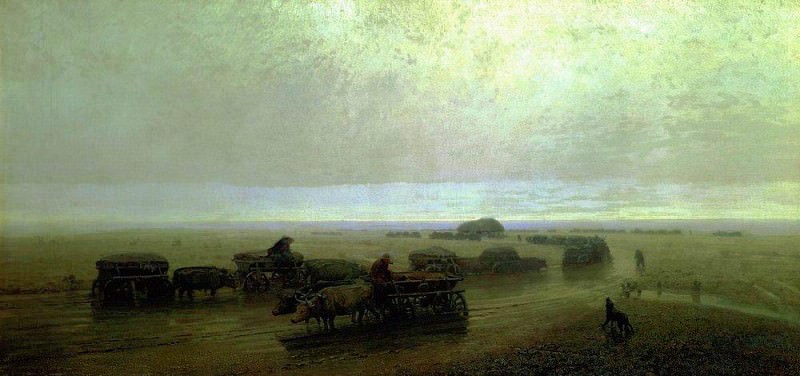Chumatsky tract in Mariupol. Arhip Kuindzhi (Kuindschi) (1842-1910)
Arhip Kuindzhi – Chumatsky tract in Mariupol.
Edit attribution
Download full size: 1000×470 px (0,1 Mb)
Painter: Arhip Kuindzhi (Kuindschi)
Kuindzhi created the work Chumatsky Trakt in Mariupol in order to gain recognition from the artists-permovementists at the next exhibition. The artist hoped to highlight its realism as the painting’s main feature, and he succeeded admirably. In this work Kuindzhi portrayed familiar to him in great detail home Mariupol. After all, it is the painter’s hometown, where he was born and grew up, and on the road passing through the vast southern steppes Chumak often went to Feodosia.
Description of Arkhip Kuindzhi’s painting Chumatsky Trakt in Moreupol
Kuindzhi created the work Chumatsky Trakt in Mariupol in order to gain recognition from the artists-permovementists at the next exhibition. The artist hoped to highlight its realism as the painting’s main feature, and he succeeded admirably.
In this work Kuindzhi portrayed familiar to him in great detail home Mariupol. After all, it is the painter’s hometown, where he was born and grew up, and on the road passing through the vast southern steppes Chumak often went to Feodosia. The road received its name from the Chumak traders, who used to carry goods from one town to another. Most often their wagons carried fish and salt.
The work depicts a road in which these ox-drawn trading wagons rush about. This work is associated with wet weather. The road is wet and muddy, the carts and cattle glisten with rain, and the sky is covered with clouds. The wet road, completely soaked from the rain and turned into a muddy mess, the carts and cattle glistening with rainwater, and the leaden, gloomy sky. This sight makes one sympathize with the chumaks, for one doesn’t even want to go out in such weather without an absolute necessity, to say nothing of setting out on a long journey. But the traders must wade through the mud to make money and feed their families.
The plot of the work may seem somewhat monotonous, but if you look closely, you can’t help but notice that the work is filled with seemingly incongruous colors. There are complex coloristic solutions, such as multifaceted transitions from cold to warm tones. Green, white, yellow, and blue dominate the painting.
As in many of Quindzhi’s works, a separate and decisive role in the composition is played by the sky. The clouds have become heavier from the rain, but in the gray clouds there is a noticeable bright spot in the middle. There is bright light oozing out of the sky, although the sun is not visible at all. It is as if the sky is about to fall on the people below. This effect gives the viewer a sense of hopelessness and doom.
The Peredvizhniki appreciated this work of the author, as such social subtext is very close to this movement. This allowed the artist to find a foothold in creative endeavors. However, in the further creativity of the author’s way with the Itinerants diverged.
However, it should be noted that "Chumacki Tract" - not a passing work by Kuindzhi in a particular stage of his career. This picture was recognized and gave the artist the confidence necessary to come from a poor family. This confidence allowed him to believe in his own strength and leave the Academy of Arts for his own experience.
Кому понравилось
Пожалуйста, подождите
На эту операцию может потребоваться несколько секунд.
Информация появится в новом окне,
если открытие новых окон не запрещено в настройках вашего браузера.
You need to login
Для работы с коллекциями – пожалуйста, войдите в аккаунт (open in new window).




















COMMENTS: 2 Ответы
ууурррааа ))) классно
Невероятно.
You cannot comment Why?
This painting depicts a Chumatsky tract, a scene of traditional salt and grain trade routes in Ukraine, specifically near Mariupol.
What I see:
Subtexts: